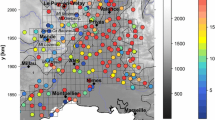Abstract
Historically, most precipitation data have been measured by collecting rainfall, usually at intervals of 24 h, with a fixed starting time. Nonetheless, it is known that the use of fixed time intervals to measure rainfall quantities could lead to an underestimation of the true maximum precipitation amounts for the considered duration, so a single multiplicative correction factor is commonly applied, generally without taking into account the rainfall pattern of the place, nor regional or seasonal considerations. In the present work, hourly measurements from 120 stations of Catalonia (northeast of the Iberian Peninsula) have been used to analyse how the ratio between rainfall amounts measured by fixed and unrestricted intervals, i.e. the correction factor, depends on the considered duration and on the specific starting time of the fixed interval (local 00:00, 08:00, 12:00 or 16:00), as well as the influence of geographical location and seasonality and actual rainfall duration. For fixed sampling intervals starting at 16:00, the mean correction factor has been found to be higher (1.137) than at the usual 08:00 starting time (1.129). Some geographical patterns of the correction factor over Catalonia arose which, moreover, depend on the season, with a mean value of 1.161 in spring and a value of 1.093 in summer. Also, the value of the correction has been found to increase with the actual duration of the maximum rainfall events used in the analysis. Some of these extreme events had actual mesoscale durations between 6 and 9 h, linked to highly convective mesoscale organisations acting mainly in summer and the beginning of autumn. Other maxima episodes, with more advective rainfall lasting more than 12 h registered in the northern area of the territory, presented the highest values of the correction factor, especially in spring.











Similar content being viewed by others
Data availability
The rainfall data used to support the findings of this study were supplied by Servei Meteorològic de Catalunya (Generalitat de Catalunya) and are available by request to dades.meteocat@gencat.cat.
References
Asquith WH (1998) Depth-duration frequency of precipitation for Texas. USGS Water-Resources Investigations Report 98–4044. https://doi.org/10.3133/wri984044
Casas MC, Codina B, Redaño A, Lorente J (2004) A methodology to classify extreme rainfall events in the western Mediterranean area. Theor Appl Climatol 77:139–150. https://doi.org/10.1007/s00704-003-0003-x http://rdcu.be/IiC4
Casas MC, Rodríguez R, Nieto R, Redaño A (2008) The estimation of probable maximum precipitation: the case of Catalonia. Ann N Y Acad Sci 1146:291–302. https://doi.org/10.1196/annals.1446.003
Casas-Castillo MC, Llabrés-Brustenga A, Rius A, Rodríguez-Solà R, Navarro X (2018) A single scaling parameter as a first approximation to describe the rainfall pattern of a place: application on Catalonia. Acta Geophys 66(3):415–424. https://doi.org/10.1007/s11600-018-0122-5
Dwyer IJ, Reed DW (1995) Allowance for discretization in hydrological and environmental risk estimation. Wallingford, Institute of Hydrology, 51pp. (IH Report no.123). http://nora.nerc.ac.uk/id/eprint/7366
Hershfield DM (1961) Rainfall frequency atlas of the United States for durations from 30 minutes to 24 hours and return periods from 1 to 100 years. Weather Bureau Technical Paper 40, U.S. Weather Bureau: Washington, D.C., 115 pp. http://www.nws.noaa.gov/oh/hdsc/PF_documents/TechnicalPaper_No40.pdf
Huff FA, Angel JR (1992) Rainfall frequency atlas of the Midwest. Illinois State Water Survey, Champaign, Bulletin 71. http://hdl.handle.net/2142/94532
Llabrés-Brustenga A, Rius A, Rodríguez-Solà R, Casas-Castillo MC, Redaño A (2019) Quality control process of the daily rainfall series available in Catalonia from 1855 to the present. Theor Appl Climatol 137(3–4):2715–2729. https://doi.org/10.1007/s00704-019-02772-5
Morbidelli R, Saltalippi C, Flammini A, Cifrodelli M, Picciafuoco T, Corradini C, Casas-Castillo MC, Fowler JH, Wilkinson SM (2017) Effect of temporal aggregation on the estimate of annual maximum rainfall depths for the design of hydraulic infrastructure systems. J Hydrol 554:710–720. https://doi.org/10.1016/j.jhydrol.2017.09.050
Morbidelli R, Saltalippi C, Flammini A, Picciafuoco T, Dari J, Corradini C (2018) Characteristics of the underestimation error of annual maximum rainfall depth due to coarse temporal aggregation. Atmosphere 9(8):303. https://doi.org/10.3390/atmos9080303
Papalexiou SM, Dialynas YG, Grimaldi S (2016) Hershfield factor revisited: correcting annual maximum precipitation. J Hydrol 542:884–895. https://doi.org/10.1016/j.jhydrol.2016.09.058
Pérez-Zanón N, Casas-Castillo MC, Rodríguez-Solà R, Peña JC, Rius A, Solé JG, Redaño A (2016) Analysis of extreme rainfall in the Ebre Observatory (Spain). Theor Appl Climatol 124:935–944. https://doi.org/10.1007/s00704-015-1476-0 http://rdcu.be/IiB5
Pérez-Zanón N, Casas-Castillo MC, Peña JC, Aran M, Rodríguez-Solà R, Redaño A, Solé JG (2018) Analysis of synoptic patterns in relationship with severe rainfall events in the Ebre Observatory (Catalonia). Acta Geophys 66(3):405–414. https://doi.org/10.1007/s11600-018-0126-1
SMC (2008) Atles Climàtic de Catalunya 1961–1990 (ed. 2008). Servei Meteorològic de Catalunya, Departament de Territori i Sostenibilitat, Generalitat de Catalunya. Available at: http://www.meteo.cat/climatologia/atles_climatic/
van Montfort MAJ (1997) Concomitants of the Hershfield factor. J Hydrol 194:357–365. https://doi.org/10.1016/S0022-1694(96)03212-X
Weiss LL (1964) Ratio of true to fixed-interval maximum rainfall. J Hydraul Div 90(1):77–82
Yoo C, Jun C, Park C (2015) Effect of rainfall temporal distribution on the conversion factor to convert the fixed-interval into true-interval rainfall. J Hydrol Eng 20(10). https://doi.org/10.1061/(ASCE)HE.1943-5584.0001178
Young CB, McEnroe BM (2003) Sampling adjustment factors for rainfall recorded at fixed time intervals. J Hydrol Eng 8(5):294–296. https://doi.org/10.1061/10.1061/(ASCE)1084-0699(2003)8:5(294)
Acknowledgements
We gratefully acknowledge to Servei Meteorològic de Catalunya (Generalitat de Catalunya) for providing the data used in this work. The authors would like to thank the editor and the anonymous reviewers for their valuable comments and suggestions to improve the manuscript.
Author information
Authors and Affiliations
Corresponding author
Ethics declarations
Conflict of interest
The authors declare that they have no conflict of interest.
Additional information
Publisher’s note
Springer Nature remains neutral with regard to jurisdictional claims in published maps and institutional affiliations.
Rights and permissions
About this article
Cite this article
Llabrés-Brustenga, A., Rius, A., Rodríguez-Solà, R. et al. Influence of regional and seasonal rainfall patterns on the ratio between fixed and unrestricted measured intervals of rainfall amounts. Theor Appl Climatol 140, 389–399 (2020). https://doi.org/10.1007/s00704-020-03091-w
Received:
Accepted:
Published:
Issue Date:
DOI: https://doi.org/10.1007/s00704-020-03091-w




